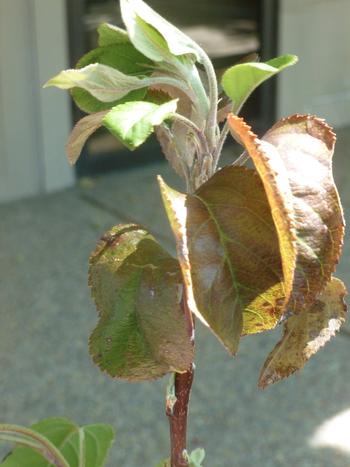Powdery mildew
-
Martha Proctor
-
Due to California’s dry summers, powdery mildews are more prevalent in Marin County than many other leaf-infecting diseases. These fungi affect virtually all kinds of plants: cereals, grasses, vegetables, flowers, shrubs, fruit trees, broad-leafed shade, and forest trees. If you observe grayish-white powdery spots on the upper surface of lower leaves, on shoots, and sometimes flowers and fruit, it is likely that you’re seeing evidence of powdery mildew fungi.
 Powdery mildew on an apple tree. Photo: Martha Proctor
Powdery mildew on an apple tree. Photo: Martha ProctorPowdery mildew fungi produce & disperse spores into the air in spring when temperatures rise above 60 °F. Infections occur when spores reach a suitable host. There are more than 1,100 powdery mildew fungi, all of which are host specific. The type and severity of symptoms depend on the variety of the host plant, the age, and condition of affected tissue, environmental conditions, and the specific species of powdery mildew fungi involved. Infections are spread to other locations on the plant or nearby plants by wind and splashing rain. High humidity favors spore formation, while low humidity favors spore dispersal.
As the disease progresses, leaves become yellow, curled, and distorted. In severe cases, leaves turn brown, then wilt and die. Affected buds or shoots become distorted, dwarfed, and discolored. Severely affected flowering plants have reduced yields, shortened production times, and fruit with little flavor. Damage is more unsightly than harmful on most trees.
Shade, warm days (60o F to 80o F) and cool nights, poor air circulation through overcrowded plantings, and relative humidity greater than 95% favor the onset and spread of the disease. Unlike other foliar diseases, water on leaves is not a requirement for infection.
Moderate levels of powdery mildew can be ignored on most plant species. Still, prevention and immediate control activities should be taken to avoid damaging highly susceptible plants such as certain cultivars of azalea, dogwood, dahlia, rhododendron, apple, crape myrtle, euonymus, stone fruit, and rose. Once present, the fungus survives the winter attached to plant parts or its fallen leaves. If you see powdery mildew on a few leaves, removing them will help with control. At the end of the growing season, prune out infected stems and remove fallen leaves as they serve as a source of further infection.
Instituting the cultural practices listed below will reduce the incidence of powdery mildew:- Choose resistant varieties
- Use slow-release fertilizers. Avoid excessive or late summer application of nitrogen fertilizer to limit new growth as it’s more susceptible to infection.
- Wash spores off infected plants with overhead sprinkling in the early morning so plant tissue dries as soon as possible.
- For infected vegetables and other annuals, remove as much of the plant and its debris in the fall. Green waste from infected plants should be composted commercially.
- Selectively prune overcrowded plants to help increase air circulation.
If the above practices fail to prevent disease, an application of fungicide may be necessary. A protectant fungicide prevents new infections from occurring, whereas eradicants can kill an existing infection. Thoroughly cover a highly susceptible plant with protectant fungicide (e.g., sulfur or sulfur combined with soap {M-Pede, Safer Garden fungicide} applied regularly in 7-10 day intervals) before the disease appears. Use eradicants (horticultural oils) at the earliest signs of disease. Monitor plants with a severe infection the following spring so if infections reoccur, they are treated early. Chemicals are most effective when combined with cultural controls. Powdery mildew seen on a dahlia leaf. Photo: Martha Proctor
Powdery mildew seen on a dahlia leaf. Photo: Martha Proctor
Once the mildew growth is extensive, controlling the situation with any fungicide becomes more difficult. Do not apply sulfur or horticultural oil when the temperature is 90oF or above or to water-stressed plants; sulfur should not be applied within two weeks of any oil spray. Sulfur products have been used for centuries to manage powdery mildew but are only effective when applied before the disease appears.
The first line of defense is to promote healthy plants—plant highly susceptible plants in good soil and sunny locations that allow good air circulation.


